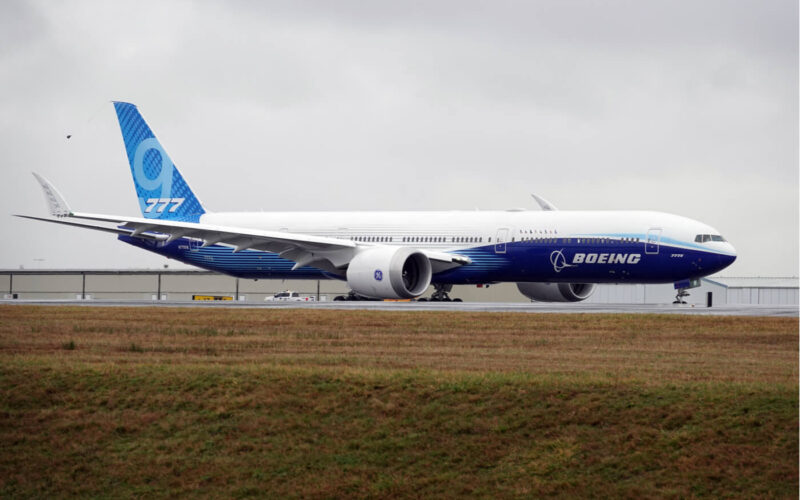Since the first Boeing 777 entered commercial service in 1995, the aircraft family has become the most successful manufacturer’s wide-body. As the newest member of the family, and the first aircraft of the latest generation, is moving ahead in the production program, let’s take a look at what makes the Boeing 777X similar ‒ and different ‒ from its predecessors.
Brief history of Boeing 777 aircraft family
The Boeing 777X is the third generation of Boeing’s best selling Triple Seven wide-body family. Since the first aircraft of the family entered service in 1995, Boeing has already released five different variants of the airliner for passenger service, one freighter version and is currently getting ready to offer the sixth one.
Boeing 777 Classics, the first generation of Triple Sevens, includes the 777-200, 777-200ER and 777-300. Together, the three versions accumulated 570 orders, the manufacturer’s books show.
The second generation includes 777-300ER and 777-200LR. The production freighter model, the 777F, also tracks roots to this generation, as its structural design and engine specifications derive from the -200LR, while tanks ‒ from -300ER.
The first model in the series was the 777-300ER, which entered service in 2004. The model soon became the shining star in Boeing’s order books, as it alone attracted more orders than the previous generation all together ‒ 838. Together with the -200LR, the second generation of Triple Sevens attracted 899 orders.
However, the time of the second generation is coming to the end, at least on the manufacturer’s part, as Boeing had only 20 remaining orders to be delivered as of January 31, 2020. Thus, the Boeing 777X is about to enter the scene.
Boeing 777X unveiled
The third generation of Triple Sevens will be composed of two airliners, the 777-8 and 777-9, with the latter entering service first. The -9 will be the longer/larger version of the two, featuring more passenger seats but less range.
When compared to the previous generation, the new 777X stand out by their sheer size and range. In fact, the shorter new 777X version would seat as many passengers as the largest of the previous generations.
The -9 version could be seen as derivative of the -300ER, but will have a greater range (7,525 nautical miles versus 7,370 nmi), longer fuselage (76.7 meters versus 73.86), and the ability to seat up to almost 50 more passengers (414 seats in a typical three-class configuration versus 365) than the predecessor. Meanwhile, the -8 version would compare to the -200LR, but instead of 8,555 nmi will have a range of 8,690 nmi instead of 301, and the fuselage, stretched by 6.07 m, will seat 365 passengers (in a 3-class configuration).
The new aircraft to come with new features, the most appealing of which, to airlines at least, being the promised 14% savings on costs, when compared to older generations of 777s. On the technical side, the airline is promised to have improved pilot technology including better turbulence detectors and autopilot systems. The new planes should be more appealing to passengers too, according to Boeing, which promotes larger windows, a wider cabin, new lighting, and new architecture among the main features to lure customers onboard the new 777X.
However, it is not these features that 777X hype revolves around.
Key elements of the future Boeing 777X
When at the gate, the Boeing 777X would have the same wingspan as the second-generation counterparts. The catch? This wingspan would only be used once the plane is on the ground. The wingspan inflight, enabled by the folding wings technology, would be a whole different story – and a new chapter in commercial aviation history.
The aircraft’s tips can be folded up to increase the wingspan from 64.8 m, when the aircraft is on the ground, to 71.8 m during the flight. The trick allows the mammoth aircraft onto taxiways or into regular gates. Meanwhile, the extended wingspan comes handy off-ground, as they allow to increase lift capacity and maximize fuel efficiency.
While an aircraft with folding wings is not unheard of in aviation, the Boeing 777X is the first passenger aircraft with the feature. Similar aircraft are actually already in use, even by Boeing itself. They can be seen on military planes operating from aircraft carriers, such as the Boeing F/A-18E/F Super Hornet.
The Boeing 777X will be powered by General Electric (GE) GE9X engines, built exclusively for the latest version of Boeing’s long-haul wide-body. The engine is developed on the foundations of the GE90, which powers the earlier versions of Boeing 777. Launched in 2013, the GE9X engine will be the most fuel-efficient jet engine the company has ever produced on a per-pounds-of-thrust basis, according to GE itself.
When it enters service with the 777X, power plant, which is roughly the size of a 737’s fuselage, will be the largest commercial jet engine available.
Boeing 777X in short:
- Program officially launched in November 2013
- Distinguishing features: folding wings, huge engines, first two-engine airliner to seat 400+ passengers
- Maiden flight in January 2020
- Service entry expected in 2021
- Biggest customer: Emirates (115 planes on order)
- Total orders so far: 309

